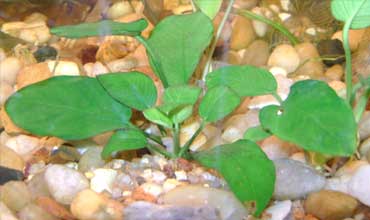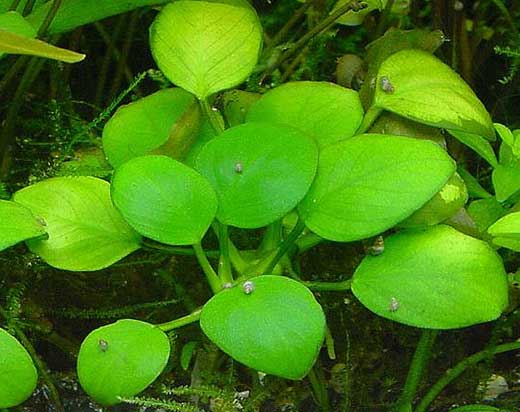Anubias Nana
The most popular plant in the entire aquarium hobby could very well be the Anubias nana. This is because the plant can be cared for easily and is very hardy. The plant is sometimes called the Dwarf Anubias or the Nana plant. The plant is native to south eastern Nigeria, Bioko, West Africa, and Cameroon, and has since been distributed widely around Europe, Asia, and USA.
- Scientific name: Anubias barteri var. nana (Anubias nana)
- Common name: Anubias nana, Dwarf Anubias, Nana
- Origin: Cameroon, West Africa
- Propagation: Rhizome division
- Placement: Foreground or mid-ground
- Maximum size: 20 cm
- Care level: Easy
- pH: 6.0-7.5
- Hardness: 3-8 dGH
- Temperature: 72-820F
- Lighting: Low – Moderate
- Growth: Slow
Table of Contents
Introduction
Growth and Care
Propagation
Compatability
It is found in shallow, temporary reservoirs in the wild. It also turns up in ponds, ditches, streams, forested areas, rivers, and marshes. It is found along banks with muddy bottoms and at variable water levels. It can also turn up on logs and large stones.
The plant is now cultivated around the world and used in aquariums and plaudariums.
Anubias nana is a sturdy and adaptable plant, making it a favorite for many hobbyists. It can reach lengths of up to 20 cm and has stunning dark green leaves, and a short and thick branching rhizome.
The stem of the plant is thick and the blades of the leaves reach 8 cm long and 3 cm wide. They have an elliptical shape and pointed tips. The underside of a leaf is a lighter green with visible veins. The plant can be placed in the mid-ground or foreground of an aquarium. It should be attached to bogwood or rocks. It gives the aquarium a touch of color and beauty, while improving the quality of the water in the aquarium. It is best when placed in aquariums housing fish species that nibble and uproot plants. There are some exceptions to this of course. It works as the ideal hiding place for small fish such as fry fish.
It is able to produce side shoots and it also grows horizontally by producing stems and leaves from central roots or rhizomes. If the plant is properly taken care of, it will propagate easily in an aquarium with good conditions. This plant is robust and able to live for several years, no matter whether it is partially or fully submerged.
Growth and Care
This is a popular plant for aquariums and is beloved by beginners and experienced aquarists alike. The plant is adaptable, able to tolerate different levels of hardness and pH levels in water, as well as different lighting conditions. It thrives most in moderate lighting, hardness of 3 – 8 Dgh, a pH level of between 6.0 and 7.5, and a temperature between 72-82 Fahrenheit. To give the plant enough light, you should use 2-3 watts of light per gallon of water. The light should be turned on consistently for between 10-14 hours a day. The bottom of the tank should have a 2-3mm layer of gravel or a 1-2mm layer of coarse sand.
Propagation
Propogation is easy in aquariums when treated properly. Add fertilizers to the water to encourage the plant to grow properly, and maintain good levels of CO2 and lighting. Add some gravel, aquarium substrate, driftwood, rocks, or decorations to the tank as well.
Cuttings taken from the plant should have three leaves at the very least. Plant these new pieces into the substrate. Pay special attention to the roots and rhizome when planting. Avoid burying the rhizome beneath the substrate, as this causes it to rot and die. The cutting should produce roots in a few days and anchor itself to the substrate ready to start growing. There are also rare occasions where the plant is able to reproduce sexually through producing seeds.
Compatibility
It should be planted in a shaded area or a place with medium light levels to prevent algae growing on the leaves. Place rocks or wood in the tank to tie the roots against the substrate. To avoid damaging the plant it’s best to use light fishing line or cotton thread. The plant will grow slowly in a single, horizontal direction. The CO2 that your fish exhale should be enough for it, with no need to add extra CO2.
It does need the water to be changed regularly and an occasional bit of fertilizer such as liquid plant food. The plant also needs a supply of trace elements to stay healthy. This species is ideal for tanks filled with herbivorous fish and cichlids. The leaves are broad, providing plenty of hiding space for smaller and shy fish. If algae does grow on the leaves, it makes a great snack for shrimp and snails that eat algae.



